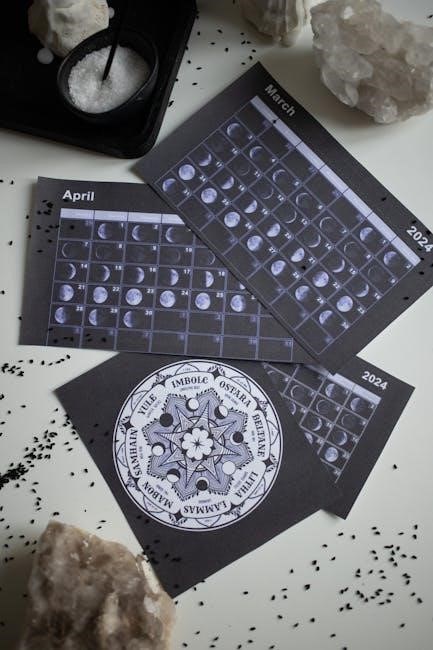
The Julian calendar, introduced by Julius Caesar in 45 BCE, is a solar-based calendar with 365-day years and leap years every four years.
It was designed to simplify the Roman lunar calendar but differs from the modern Gregorian calendar. PDF versions of the Julian calendar are widely available for historical, religious, or cultural use.
1.1 Overview of the Julian Calendar System
The Julian calendar is a solar-based system introduced by Julius Caesar in 45 BCE, featuring a 365-day year with a leap year every four years. It consists of 12 months, with February having 28 or 29 days. This system, still used by some Eastern Orthodox churches, calculates dates differently from the Gregorian calendar. Printable Julian calendar PDFs are popular for historical, religious, or cultural purposes, often including month-by-month layouts.
1.2 Historical Background and Purpose
The Julian calendar was created to reform the chaotic Roman lunar calendar, aligning it with the solar year. Introduced by Julius Caesar in 45 BCE, it aimed to stabilize festivals and administrative cycles. Its leap year rule simplified date calculations. While the Gregorian calendar replaced it in 1582, the Julian calendar remains significant in religious contexts. PDF versions are now used for historical research and cultural practices.
1.3 Key Differences from the Gregorian Calendar
The Julian calendar differs from the Gregorian by its leap year rule and solar year accuracy. Julian adds a leap day every four years without exception, while Gregorian omits three leap days every 400 years. This causes a 13-day difference over centuries. PDF calendars highlight these variations, aiding users in historical or religious contexts. The Julian calendar remains vital for Eastern Orthodox traditions.

Structure of the Julian Calendar
The Julian calendar organizes time into years, months, and days, with 365 or 366 days annually.
Its structure includes 12 months and a leap year system. PDF versions detail this format, aiding historical and cultural studies.
2.1 Months and Days in the Julian Calendar
The Julian calendar comprises 12 months, each with a fixed number of days, totaling 365 days annually.
Months alternate between 31 and 30 days, with February having 28 or 29 days during leap years. PDF versions of the Julian calendar outline these structures, providing a clear and organized format for users. This system ensures consistency and simplicity in tracking dates and events historically.
2.2 Leap Year Rules in the Julian Calendar
The Julian calendar designates a leap year every four years without exception, adding a leap day to February.
This rule simplifies calculations but results in a slight annual error. PDF calendars highlight leap years, aiding users in tracking these adjustments. The Julian system remains consistent, though less accurate than the Gregorian calendar, which skips three leap years every 400 years to correct the error.
2.3 Calculation of Julian Dates
Julian dates are calculated using a continuous count of days since January 1, 4713 BCE.
This system assigns a unique number to each day, simplifying time interval calculations. PDF calendars often include Julian dates, aiding in astronomical observations and historical research. The Julian date formula converts Gregorian dates, ensuring accuracy for scientific and cultural applications. This method remains essential for tracking celestial events and maintaining chronological precision.

The Julian Calendar vs. the Gregorian Calendar
The Julian and Gregorian calendars differ in leap year rules, causing a 13-day discrepancy over centuries. PDF calendars highlight these variations for historical and cultural reference.
The transition from the Julian to the Gregorian calendar was driven by the need to correct the drift in the date of Easter. The Julian calendar calculates leap years every four years without exception, while the Gregorian omits three leap years every 400 years. The Julian calendar remains significant in religious practices, particularly for Eastern Orthodox Churches, which use it to determine holy days like Easter and Christmas. The Julian calendar holds deep religious and cultural importance, particularly in Eastern Orthodox traditions, where it guides sacred celebrations and rituals. Eastern Orthodox Churches predominantly use the Julian calendar to determine liturgical dates, including Christmas and Easter. This tradition ensures spiritual continuity and connection to historical practices. The Julian calendar plays a crucial role in observing religious holidays, particularly in Eastern Orthodox and Oriental Orthodox traditions. The Julian calendar is deeply rooted in cultural traditions, especially among communities that continue to use it for religious and historical purposes. The Julian calendar remains useful for historical research, astronomical calculations, and religious practices. The Julian calendar plays a crucial role in astronomical calculations due to its continuous day count system. Historians rely on the Julian calendar to date events before the Gregorian reform. The Julian calendar remains vital in certain cultural and religious communities, such as Eastern Orthodox Churches. Downloadable Julian calendar PDFs are available online for free or customizable use. To download a printable Julian calendar PDF, visit reliable websites offering free templates. Download the Julian calendar PDF and edit it using software like Adobe Acrobat or Microsoft Word. Julian calendar PDFs are available in various formats, including yearly and monthly layouts. The conversion involves adjusting for the 10-13 day difference between the calendars. Converting Gregorian to Julian dates involves accounting for the 10- to 13-day difference due to historical calendar reforms. Various tools and formulas simplify converting Gregorian to Julian dates. When converting Gregorian to Julian dates, common errors include miscalculating leap years and ignoring the 10-day difference introduced by the Gregorian reform. The Julian calendar is used in astronomy for calculating Julian dates, essential for astronomical observations and timekeeping. It ensures synchronization with celestial events and accurate monitoring. Julian dates play a crucial role in astronomy by providing a continuous count of days since January 1, 4713 BCE. This system eliminates the confusion of varying month lengths and leap years, enabling precise tracking of celestial events. Astronomers use Julian dates to calculate phenomena like planetary alignments and eclipses accurately. Their uniformity simplifies data analysis across long periods, making them indispensable for scientific research and observations. Julian dates are essential for synchronizing astronomical observations with celestial events. By providing a continuous day count, they eliminate discrepancies caused by varying month lengths and leap years. This consistency allows astronomers to accurately predict and record events like eclipses and planetary alignments. The Julian calendar’s uniformity ensures precise alignment with cosmic phenomena, making it a vital tool for maintaining accurate and reliable astronomical records. The Julian calendar plays a crucial role in scientific research by providing a standardized system for timekeeping. Its continuous day count eliminates errors from irregular month lengths and leap years, ensuring precise data collection. This accuracy is vital for long-term studies, such as climate monitoring and astronomical observations, where consistency is key. The Julian calendar’s reliability makes it an indispensable tool for maintaining precise scientific records and calculations. The Julian calendar has marked numerous historical events, such as its introduction by Julius Caesar in 45 BCE and its gradual replacement by the Gregorian calendar; Julius Caesar introduced the Julian calendar in 45 BCE, replacing the chaotic Roman lunar calendar. This reform, supported by astronomer Sosigenes, created a 365-day solar year with a leap year every four years. The new system aligned the calendar with the seasons, stabilizing civil, religious, and agricultural activities. Caesar’s reform remained in use for over 1,500 years, shaping modern timekeeping systems globally. The shift from the Julian to the Gregorian calendar occurred at different times globally. Pope Gregory XIII introduced the Gregorian calendar in 1582, but adoption was gradual. Spain, Italy, and Portugal switched immediately, while Protestant and Orthodox nations resisted due to religious ties. Russia adopted it in 1918, and Greece in 1924. This staggered transition caused discrepancies in historical records and religious observances, reflecting cultural and political divides. The Julian calendar records significant historical events, such as the coronation of Russian tsars and Orthodox religious festivals. Key dates include the implementation of the Julian calendar in 45 BCE and the first day of Ramadan in 2025 as February 10. These events highlight the calendar’s enduring relevance in religious and cultural contexts, even as the Gregorian calendar prevails in modern society. The Julian calendar remains relevant in specific religious and cultural contexts, with PDF downloads and digital tools ensuring its preservation and accessibility for future generations. The Julian calendar maintains its relevance today, particularly in religious and cultural practices. Many Eastern Orthodox churches still use it to determine holy days. Additionally, astronomers and researchers utilize Julian dates for precise time calculations due to their continuous count system. The availability of Julian calendar PDFs has made it accessible for personal, religious, and academic purposes, ensuring its enduring utility in a modern context. The Julian calendar is expected to remain relevant in niche contexts, particularly within religious communities and astronomical applications. Its continued use in Eastern Orthodox traditions and scientific calculations ensures its endurance. PDF templates of the Julian calendar cater to these specific needs, allowing for easy adaptation and distribution among communities and researchers who rely on its structure for religious observances and precise timekeeping. The Julian calendar’s digital integration is growing, with PDF templates and online tools offering easy access and customization. Digital platforms preserve its historical significance while making it user-friendly for modern needs. This blend of tradition and technology ensures the Julian calendar remains accessible and relevant, supporting its continued use in cultural, religious, and academic contexts.3.1 Historical Reasons for the Transition
The Julian calendar had an error in its leap year system, causing a discrepancy of about 11 minutes annually, which added up over centuries.
This led to a 10-day difference by the 16th century, prompting Pope Gregory XIII to introduce the Gregorian calendar in 1582.
PDF resources detail this historical shift, explaining how it aligned religious observances with astronomical events more accurately.3.2 Differences in Date Calculation
This results in a slight difference in date calculations, with the Julian calendar accumulating an error of about 11 minutes annually.
Over centuries, this discrepancy grew, leading to a 10-day difference by the 16th century.
PDF guides often illustrate these calculation differences, helping users understand the two systems.3.3 Impact on Religious and Cultural Practices
This creates cultural traditions tied to these dates, often differing from Gregorian celebrations.
Many communities rely on Julian calendar PDFs to maintain these practices, preserving cultural heritage and religious observances.
Religious and Cultural Significance
Its use preserves cultural heritage and maintains continuity in religious practices, with many communities relying on Julian calendar PDFs for observances.4.1 Use in Eastern Orthodox Churches
Many Orthodox communities rely on Julian calendar PDFs to plan religious observances, preserving cultural and theological heritage. The calendar’s steadfast use reflects deep-rooted faith and tradition within these communities.4.2 Observance of Religious Holidays
Holidays like Christmas and Easter are calculated based on Julian dates, often resulting in different celebration dates than the Gregorian calendar. PDF versions of the Julian calendar are essential tools for followers to track and prepare for these sacred occasions, ensuring spiritual alignment with ancient practices.4.3 Cultural Traditions Associated with the Julian Calendar
Many festivals and celebrations, such as certain Eastern Orthodox holidays, are tied to Julian dates, preserving cultural heritage. PDF calendars are often used to maintain these traditions, ensuring that cultural practices remain vibrant and connected to their historical roots.
Practical Applications of the Julian Calendar
PDF versions are popular for planning and tracking events in specific communities, blending tradition with modern convenience.5.1 Astronomical Calculations and Julian Dates
This method eliminates the confusion of varying month lengths and leap years, simplifying precise calculations for celestial events.
Astronomers use Julian dates to synchronize observations with planetary alignments and eclipses accurately.
Printable PDF calendars often include Julian dates, aiding researchers in tracking astronomical phenomena efficiently.
5.2 Use in Historical Research
Its consistent structure aids in aligning historical records with modern timelines.
Printable PDF versions of the Julian calendar are valuable tools for scholars, offering a clear reference for ancient and medieval chronology.
This system ensures accuracy in studying past cultures and events, bridging the gap between historical and contemporary datekeeping.5.3 Modern-Day Usage in Specific Communities
Many still observe religious holidays and traditions based on its dates.
Additionally, some cultural practices and historical reenactments use the Julian calendar to maintain authenticity.
Printable PDF versions of the Julian calendar are popular among these groups for planning and reference. Its continued use highlights its enduring relevance in niche contexts.

How to Download and Use a Julian Calendar PDF
These templates often include both Julian and Gregorian dates for easy reference.
Users can print or edit them for personal, religious, or cultural purposes.
Websites offer various formats, ensuring accessibility and convenience for all users.6.1 Steps to Download a Printable Julian Calendar
Search for “Julian calendar PDF” and select your preferred year and format.
Choose between editable Word, Excel, or direct PDF downloads.
Customize the template if needed, then print it for personal or religious use.
Ensure the calendar aligns with your specific requirements for holidays or cultural observances.6.2 Customizing the Calendar for Personal Use
Add personal events, holidays, or notes to make it more relevant.
Customize fonts, colors, and layouts to suit your preferences.
Include important dates or cultural traditions specific to your needs.
Save and print the tailored version for daily or religious use. This ensures the calendar meets your unique requirements.6.3 Examples of Printable Templates and Formats
Popular options include portrait and landscape orientations, with some featuring US holidays and week numbers.
Editable Word and JPG versions allow for customization, while perpetual calendars offer long-term planning.
These templates cater to personal, religious, or cultural needs, ensuring flexibility and practicality for users.
Converting Gregorian Dates to Julian Dates
Online tools and formulas simplify the process for accuracy and convenience.7.1 Understanding the Conversion Process
The process requires adjusting for the shift introduced by the Gregorian calendar’s adoption. PDF guides often include formulas or tables to simplify the conversion.
Understanding the rationale behind the discrepancy is key to accurate date translation.7.2 Tools and Formulas for Date Conversion
Online calculators and spreadsheets automate the process, while mathematical formulas allow manual calculations. PDF resources often include step-by-step guides and conversion tables.
These tools ensure accuracy for historical research, astronomical calculations, and religious observances.7.3 Common Errors to Avoid in Conversions
Ensure accuracy by using reliable formulas or tools. PDF guides often highlight these pitfalls, providing clear instructions to avoid them. Double-checking calculations is essential for precise conversions.
The Julian Calendar in Astronomy
8.1 Role of Julian Dates in Astronomical Observations
8.2 Synchronization with Celestial Events
8.3 Importance in Timekeeping for Scientific Research

Historical Events and the Julian Calendar
9.1 Implementation of the Julian Calendar by Julius Caesar
9.2 Transition to the Gregorian Calendar in Different Countries
9.3 Notable Events and Their Julian Calendar Dates

The Future of the Julian Calendar
10.1 Relevance in the Modern World
10.2 Prospects for Continued Use in Specific Contexts
10.3 Potential for Digital Integration and Preservation